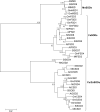Genome-wide identification and characterization of the soybean SOD family during alkaline stress
- PMID: 32071807
- PMCID: PMC7007734
- DOI: 10.7717/peerj.8457
Genome-wide identification and characterization of the soybean SOD family during alkaline stress
Abstract
Background: Superoxide dismutase (SOD) proteins, as one kind of the antioxidant enzymes, play critical roles in plant response to various environment stresses. Even though its functions in the oxidative stress were very well characterized, the roles of SOD family genes in regulating alkaline stress response are not fully reported.
Methods: We identified the potential family members by using Hidden Markov model and soybean genome database. The neighbor-joining phylogenetic tree and exon-intron structures were generated by using software MEGA 5.0 and GSDS online server, respectively. Furthermore, the conserved motifs were analyzed by MEME online server. The syntenic analysis was conducted using Circos-0.69. Additionally, the expression levels of soybean SOD genes under alkaline stress were identified by qRT-PCR.
Results: In this study, we identified 13 potential SOD genes in soybean genome. Phylogenetic analysis suggested that SOD genes could be classified into three subfamilies, including MnSODs (GmMSD1-2), FeSODs (GmFSD1-5) and Cu/ZnSODs (GmCSD1-6). We further investigated the gene structure, chromosomal locations and gene-duplication, conserved domains and promoter cis-elements of the soybean SOD genes. We also explored the expression profiles of soybean SOD genes in different tissues and alkaline, salt and cold stresses, based on the transcriptome data. In addition, we detected their expression patterns in roots and leaves by qRT-PCR under alkaline stress, and found that different SOD subfamily genes may play different roles in response to alkaline stress. These results also confirmed the hypothesis that the great evolutionary divergence may contribute to the potential functional diversity in soybean SOD genes. Taken together, we established a foundation for further functional characterization of soybean SOD genes in response to alkaline stress in the future.
Keywords: Alkaline; Evolution; Expression patterns; Phylogenetic analysis; Soybean.
© 2020 Lu et al.
Conflict of interest statement
The authors declare that they have no competing interests.
Figures








Similar articles
-
Genome-wide identification and characterization of NHL gene family in response to alkaline stress, ABA and MEJA treatments in wild soybean (Glycine soja).PeerJ. 2022 Dec 2;10:e14451. doi: 10.7717/peerj.14451. eCollection 2022. PeerJ. 2022. PMID: 36518280 Free PMC article.
-
Genome-wide identification of the rubber tree superoxide dismutase (SOD) gene family and analysis of its expression under abiotic stress.PeerJ. 2022 Oct 24;10:e14251. doi: 10.7717/peerj.14251. eCollection 2022. PeerJ. 2022. PMID: 36312747 Free PMC article.
-
Genome-wide identification and characterization of the superoxide dismutase gene family in Musa acuminata cv. Tianbaojiao (AAA group).BMC Genomics. 2015 Oct 20;16:823. doi: 10.1186/s12864-015-2046-7. BMC Genomics. 2015. PMID: 26486759 Free PMC article.
-
In silico identification and expression analysis of superoxide dismutase (SOD) gene family in Medicago truncatula.3 Biotech. 2018 Aug;8(8):348. doi: 10.1007/s13205-018-1373-1. Epub 2018 Jul 30. 3 Biotech. 2018. PMID: 30073133 Free PMC article.
-
Genome-Wide Identification and Transcriptional Expression Analysis of Cucumber Superoxide Dismutase (SOD) Family in Response to Various Abiotic Stresses.Int J Genomics. 2017;2017:7243973. doi: 10.1155/2017/7243973. Epub 2017 Jul 20. Int J Genomics. 2017. PMID: 28808654 Free PMC article.
Cited by
-
The Drought-Mediated Soybean GmNAC085 Functions as a Positive Regulator of Plant Response to Salinity.Int J Mol Sci. 2021 Aug 20;22(16):8986. doi: 10.3390/ijms22168986. Int J Mol Sci. 2021. PMID: 34445699 Free PMC article.
-
Genome-Wide Characterization of Superoxide Dismutase (SOD) Genes in Daucus carota: Novel Insights Into Structure, Expression, and Binding Interaction With Hydrogen Peroxide (H2O2) Under Abiotic Stress Condition.Front Plant Sci. 2022 Jun 8;13:870241. doi: 10.3389/fpls.2022.870241. eCollection 2022. Front Plant Sci. 2022. PMID: 35783965 Free PMC article.
-
Molecular Cloning and Functional Characterization of Heat Stress-Responsive Superoxide Dismutases in Garlic (Allium sativum L.).Antioxidants (Basel). 2021 May 20;10(5):815. doi: 10.3390/antiox10050815. Antioxidants (Basel). 2021. PMID: 34065356 Free PMC article.
-
Transcription Factor SlAREB1 Is Involved in the Antioxidant Regulation under Saline-Alkaline Stress in Tomato.Antioxidants (Basel). 2022 Aug 27;11(9):1673. doi: 10.3390/antiox11091673. Antioxidants (Basel). 2022. PMID: 36139748 Free PMC article.
-
Identification and Analysis of the Superoxide Dismutase (SOD) Gene Family and Potential Roles in High-Temperature Stress Response of Herbaceous Peony (Paeonia lactiflora Pall.).Antioxidants (Basel). 2024 Sep 18;13(9):1128. doi: 10.3390/antiox13091128. Antioxidants (Basel). 2024. PMID: 39334787 Free PMC article.
References
-
- Artimo P, Jonnalagedda M, Arnold K, Baratin D, Csardi G, De Castro E, Duvaud S, Flegel V, Fortier A, Gasteiger E, Grosdidier A, Hernandez C, Ioannidis V, Kuznetsov D, Liechti R, Moretti S, Mostaguir K, Redaschi N, Rossier G, Xenarios I, Stockinger H. ExPASy: SIB bioinformatics resource portal. Nucleic Acids Research. 2012;40(W1):W597–W603. doi: 10.1093/nar/gks400. - DOI - PMC - PubMed
LinkOut - more resources
Full Text Sources

